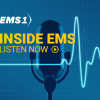Editor’s note: Welcome to the What Paramedics Want podcast series of Inside EMS, sponsored by . The state of the industry What Paramedics Want Report explores issues tied to provider recruitment and retention; safety, health and wellness support; technology adoption; and career development, produced in partnership with Fitch & Associates and the National EMS Management Association. Learn more a�Ի� download your copy.
Ever wonder what really happens inside the body during shock? This week, Chris Cebollero and Kelly Grayson dive into the renin angiotensin aldosterone system (RAAS). From vasoconstriction to fluid retention, they break down this complex topic with real-life examples, a sprinkle of humor and practical tips for how EMS providers can apply this knowledge in the field.
Kelly shares the importance of understanding the “why” behind shock presentations, from recognizing when fluids won’t work to knowing when vasopressors are the answer. With anecdotes like treating a sepsis patient on ACE inhibitors and using pulse ox waveforms for clues, this episode blends science with field-tested wisdom. Whether you’re an EMT, paramedic, or just an anatomy nerd, you’ll walk away with a clearer picture of how the RAAS keeps us alive – and how we, as EMS professionals, can work smarter alongside it.
Memorable quotes
- “It’s called, ‘The Renan Angiotensin Aldosterone System – not just a planetary belt in Star Wars’”. — Kelly Grayson
- “So, the kidneys now say, ‘We’re not getting enough blood. Here’s this renin that we’re gonna send out because we’ve gotta fix this problem.’ What the body doesn’t know is that Chris Cebollero and Kelly Grayson and you are out there trying to fix it. So it’s trying to fix itself.” — Chris Cebollero
Related resources:
- Understanding push dose pressors
- Understanding prehospital vasopressors: Dopamine, epinephrine or norepinephrine?
- A basic overview of shock for EMS
- Compensated vs. decompensated shock: what you need to know
ABOUT THE SPONSOR
Whether replacing radio reports, alerting specialty teams, or managing mass casualty incidents, Pulsara simplifies communication. Pulsara scales to meet your dynamic communication needs. From routine patient alerts to managing large-scale emergencies, every responder and clinician connects seamlessly. Familiar yet powerful, Pulsara streamlines your response, from routine transfers to regional disasters. One tool. Every day.
Regardless of event. Discover more at .
RATE & REVIEW
Catch a new episode of the Inside EMS podcast every Friday on , , , , , and . Enjoying the show? Please take a moment to . Contact the Inside EMS team at theshow@ems1.com to share ideas, suggestions and feedback, or let us know if you’d like to join us as a guest.
��ݮӰ�� is using generative AI to create some content that is edited and fact-checked by our editors.
















